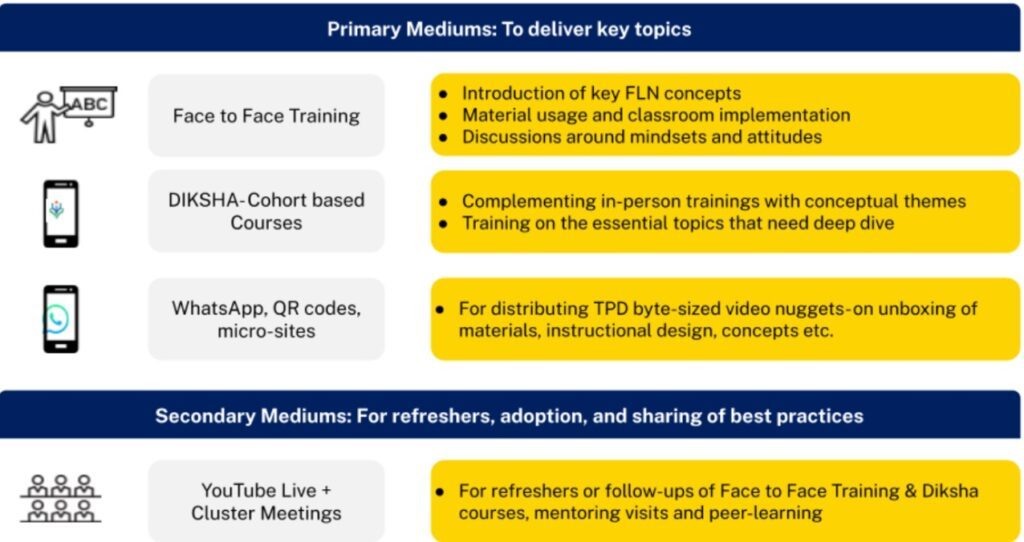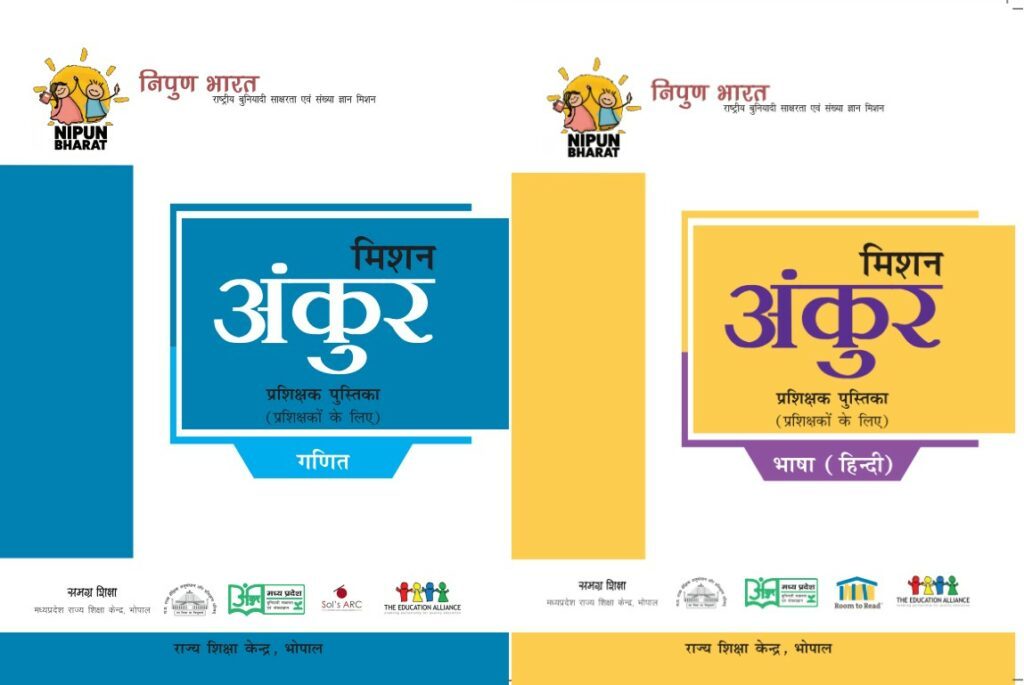 Go Back
Go BackShare
Bringing Efficiency in Face-To-Face Teacher Trainings: Learnings From Madhya Pradesh
By Vishakha Tiwari
Jul 25, 2022
The National Education Policy (NEP) 2020 calls for meaningful professional development opportunities for teachers as a key lever for improving learning outcomes. NIPUN Bharat guidelines also highlight the significance of building teacher capacity to help children acquire foundational skills. This article looks at how states can effectively invest in teacher trainings on FLN to drive learning outcomes and highlights best practices from a recent teacher training conducted in Madhya Pradesh.
India has about 7.4 million elementary teachers in 1.4 million schools (government, aided and private)[1]. Every year, states spend a significant part of their annual budgets on education, out of which more than 90% is spent on teacher salaries, teacher professional development and recruitment. States’ budgets and expenditures are heavily focused on teachers due to the critical role they play in creating an environment that supports student learning.[2] Teacher competency, effectiveness, and their motivation determine how effective the teaching and learning process in the classroom is.
The National Education Policy (NEP) 2020 advocates for meaningful professional development opportunities for teachers at all stages of their career as a key lever for improving learning outcomes. The National Initiative for Proficiency in Reading with Understanding and Numeracy Mission (NIPUN Bharat), that aims to achieve universal Foundational Literacy and Numeracy (FLN) skills among all children in the age group of 3 to 9 years by 2026-27, has highlighted the significance of building teacher capacity to help children acquire foundational skills. The NIPUN Bharat guidelines also note that the professional development program for FLN is not systematic yet due to reasons such as:
- Training without a clear competency framework;
- Dilution of quality in the cascade model of training which involves training master trainers; who then have to train other trainers
- General training without focusing on competencies teachers require to teach FLN.
With such challenges at play, how can we effectively invest in our FLN-grade teachers so that they become flag-bearers of education reform and improve classroom transactions to drive student learning outcomes? This article looks at some best practices for training teachers at scale from a recent FLN training in Madhya Pradesh, supported by CSF.
Designing holistic Teacher Professional Development (TPD) to ensure system reform
To ensure that teachers adopt skills, behaviors and attitudes that drive success in the classroom, designing a comprehensive multi-year teacher professional program is essential. Such a program must utilize a blended and multi-channel approach to design a coherent learning journey for the teachers that is also aligned with all academic inputs provided to them.

Training can be done by leveraging government platforms that have higher penetration among geographies, such as the Ministry of Education’s DIKSHA portal. However, only face-to-face training provides participants with the opportunity for experiential learning through in-person peer interactions. It also helps with demonstration of lesson plans that are close to teachers’ classroom environment.
Learnings from the face-to-face FLN training in Madhya Pradesh (MP)
Madhya Pradesh recently conducted a state-level training on FLN for more than 1500 master trainers (including teachers and cluster officers) and ~91,000 teachers. The training was conducted under Mission Ankur, the state FLN mission. CSF, along with The Education Alliance (TEA), Room to Read (RtR), and Sols Arc, is supporting the mission by providing long-term academic and project management support.
We learnt the following lessons in the process of implementing the training at scale:
1. Selecting the right trainers, trainees and adequate training days is key
Selection of who is to be trained, by whom, and for how many days is critical to ensure that the training is valuable and impactful.
The state conducted two rounds of training – five days in the first round and three days in the follow-up round – to ensure all critical aspects are covered.
Additionally, instead of training all elementary school teachers, the Rajya Shiksha Kendra (RSK), which serves as the Education Department in MP, asked each school to nominate one FLN teacher for the training. This reduced the number of training participants, helped with targeted training, and opened up the possibility for reducing cascade layers.
Usually, training at a large scale is implemented through a minimum of three cascade layers. This leads to a loss of information by the time it reaches the teachers. The training in MP, however, was implemented in two cascades by increasing the number of batches, venues and trainers to accommodate a higher number of participants while keeping the overall training time similar. 1500 master trainers were trained centrally in Bhopal first, who then went on to train the teachers directly in their respective blocks. Every block nominated four to six master trainers through a set of guidelines focused on selecting high performing subject matter experts for literacy and numeracy. Two government officials from each district also attended the entire training in the first cascade and ensured successful implementation of on-ground training to the teachers.
2. Demonstrations and activities are impactful
The training in MP focused on conducting lesson plan demonstrations, unpacking classroom material, and discussing how teachers should interact with varied learners. 98% participants found that the training was relevant to their everyday work such as going through teacher guides, student workbooks and textbooks to practice their pedagogical skills.

3. High-quality learning kits should be provided to master trainers
Each cascade in face-to-face training has trainers and participants who require different types of instructions. For example, while a teacher requires training on the concepts of FLN, the master trainer needs training on training facilitation skills as well.
To support this, training kits were provided to master trainers, which included facilitation manuals with detailed session plans and FAQs, participant handbooks with excerpts on lesson plans from teacher guides and student workbooks for demonstrations, etc. A fully functional TPD microsite was also created which provided the master trainers easy access to all training-related material.



4. Strong operational processes and clear roles and responsibilities at all levels is important for high quality delivery
Executing teacher training requires coordination across multiple levels. The training in MP used clear and simple processes such as regular attendance marking, registration of participants, capturing pre and post training assessment data, and other venue management checklists. This ensured that information on various areas flowed seamlessly from the state level to the block level. All stakeholders were also oriented on these operational processes.
Availability of the required budget, training material and equipment, and clarity on compensation and allowances for stakeholders is important to conduct teacher training smoothly. To ensure this, RSK provided adequate administrative and support staff for managing the training program at the block level. Roles and responsibilities were clearly divided among the staff. Stakeholders were oriented through multiple video conferences to ensure clarity of processes. Based on feedback from the ground post one round of training, iterations were done and administrative challenges were quickly resolved.
5. Build system ownership and review at all levels
Along with determining support structures to conduct teacher training, it is also important to set up clear accountability mechanisms. This means that top-level state, district and block officials have to be engaged in the process of providing support and reviewing progress on training delivery.
In MP, the training was consistently observed by subject matter experts and officers-in-charge for various districts. Additionally, the Additional Mission Director and Director of RSK would regularly visit the training to take direct feedback from participants.
A core monitoring group of two to three people in each district was commissioned as flying squads to observe the quality of training, interact with participants and gather feedback. The involvement of senior officials signaled the importance of the training and built requisite accountability for district and block officials to replicate at their level. It also ensured quick resolution of bottlenecks and helped iterate the training process to improve it further based on the on-ground feedback they received.
Conclusion
Apart from the above points, further improvements that can be made to deliver an effective TPD program include: analyzing the need of the teacher and improvements made post training, integrating all training sessions planned annually, and delivering FLN-focused training in a continuous and coherent manner.
Going forward, the state plans to continue supporting the teachers trained so far by providing regular inputs through classroom observation, digital courses and YouTube Live sessions to ensure adoption of practices taught in the training. These efforts culminate in ensuring long-term student learning gains.
View Article References
Keywords
Authored by
Vishakha Tiwari
Project Manager, CSF
Share this on
